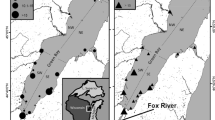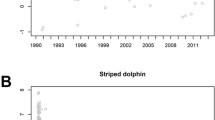Abstract
Poly-chlorinated biphenyls (PCBs) have been recognized as a significant contaminant in the Great Lakes ecosystem. Although PCBs are implicated in the reduced survival and reproductive success of several piscivorous bird species, the biological pathway in which PCBs bioaccumulate remains largely unknown. This study investigates the two most likely biological pathways, suggested via research on Great Lakes sport fish, by which PCBs would be acquired by common terns (Sterna hirundo), a piscivorous species of conservation concern. The first proposed pathway is through atmospheric deposition of PCBs which are subsequently acquired by filter-feeding fish (e.g., alewives, Alosa pseudoharengus). An alternative pathway is via the biodeposits of zebra mussels which are consumed by shallow water fish (e.g., round gobies, Neogobius melanostromus). Because common terns breed in near-shore sites where concentrations of zebra mussels are found, as well as forage in more pelagic environments it is possible that either or both pathways may be contributing to their PCB exposure. Field experiments and stable isotope analyses suggest the most likely pathway by which terns are exposed to PCBs is via alewives, similar to how apex predators such as lake trout acquire PCBs. Biodeposits from zebra mussels do not appear to be a significant factor in PCB accumulation in terns. We quantified extremely poor parental attentiveness during incubation. Although we cannot determine whether poor parental attentiveness alone or in combination with PCB contamination led to low hatching success, accumulation of PCBs appears to have significant impacts on the overall reproductive success of common terns.





Similar content being viewed by others
References
Arnold JM, Saborn D, Nisbet ICT, Hatch JJ (2006) Use of temperature sensors to monitor patterns of nocturnal desertion by incubating common terns. J Field Ornithol 77:384–391
Baker JE, Eisenreich SJ, Eadie BJ (1991) Sediment trap fluxes and benthic recycling of organic-carbon, polycyclic aromatic-hydrocarbons, and polychloro-biphenyl congeners in Lake Superior. Environ Sci Tech 25:500–509
Barrett RT (1980) Temperature of Kittiwake (Rissa tridactyla) eggs and nests during incubation. Ornis Scand 11:50–59
Becker PH, Schuhmann S, Koepff C (1993) Hatching failure in common terns (Sterna hirunda) in relation to environmental chemicals. Environ Pollut 79:207–213
Bergstrom PW (1989) Incubation temperatures of Wilson’s plovers and killdeers. Condor 91:634–641
Bosveld ATC, Gradener J, Murk AJ, Brouwer A, Van Kampen M, Evers EHG, Vanden Berg M (1995) Effects of PCDDs, PCDFs, and PCBs in common tern breeding in estuarine and coastal colonies in the Netherlands and Belgium. Environ Toxicol Chem 14:99–115
Bruner KA, Fisher SW, Lanndrum PF (1994) The role of the zebra mussel, Dresissean-polymorpha, in contaminant cycling: 1. The effect of body-size and lipid-content on the bioconcentration of PCBs and PAHs. J Great Lakes Res 20:725–734
Burger J, Gochfeld M (1997) Risk, mercury levels, and birds: relating adverse laboratory effects to field biomonitoring. Environ Res 75:160–172
Bustnes JO, Bakken V, Erikstad KE, Mehlum F, Skaare JU (2001) Patterns of incubation and nest-site attentiveness in relation of organochlorine (PCB) contamination in glaucous gulls. J Appl Ecol 38:791–801
Cho YC, Frohnhoefer RC, Rhee GY (2004) Bioconcentration and redeposition of polychlorinated biphenyls by zebra mussels (Driessena polymorpha) in the Hudson River. Water Res 38:769–777
Custer TW, Erwin RM, Stafford C (1983) Organochlorine residues in common tern eggs from nine Atlantic coast colonies, 1980. Colon Waterbirds 6:197–204
Dawson WR (1984) Metabolic responses of embryonic seabirds to temperature. In: Whittow GC, Rahn H (eds) Seabird energetic. Plenum Press, New York, pp 139–157
Fiedler H (1997) Polychlorinated biphenyls (PCBs): uses and environmental releases. In: Proceeding of the subregional awareness raising workshop on persistent organic pollutants, UN environment program. http://www.chem.unep.ch/pops/POPs_Inc/proceedings/bangkok/FIEDLER1.html
Fisher SA, Bortolotti GR, Fernie KJ, Smits JE, Marchant TA, Drouillard KG, Bird DM (2001) Courtship behavior of captive American kestrels (Falco sparveius) exposed to polychlorinated biphenyls. Environ Contam Toxicol 41:215–220
Fisher SA, Bortolotti GR, Fernie KJ, Bird DM, Smits JE (2006) Behavioral variation and its consequences during incubation for American kestrels exposed to polychlorinated biphenyls. Ecotoxic Environ Saf 63:226–235
Fox GA, Weseloh DV, Kubiak TJ, Erdman TC (1991) Reproductive outcomes in colonial fish-eating birds: a biomarker for developmental toxicants in Great Lakes food chains. J Great Lakes Res 17:153–158
France RL (1996) Absence or masking of metabolic fractionations of 13C in a freshwater benthic food web. Freshw Bio 36:1–6
French JB, Nisbet ICT, Schwable H (2001) Maternal steroids and contaminants in common tern eggs: a mechanism of endocrine disruption. Comp Biochem Physiol C 128:91–98
Gilbertson M, Morris RD, Junter RA (1976) Abnormal chicks and PCB residue levels in eggs of colonial birds on the lower Great Lakes (1971–1973). Auk 93:434–442
Gilbertson M, Kubiak T, Ludwig J, Fox G (1991) Great Lake embryo mortality, edema, and deformities syndrome (GLEMEDS) in colonial fish-eating birds: similarity to chick-edema disease. J Toxicol Environ Health 33:455–520
Grant GS (1982) Avian incubation: egg temperature, nest humidity, and behavioral thermoregulation in a hot environment. Ornithol Monogr 30:1–100
Grasman KA, Fox GA, Scanlon PF (1998) Reproductive and physiological effects of environmental contaminants in fish-eating birds of the Great Lakes: a review of historical trends. Environ Monit Assess 53:117–145
Hays H, Risebrough RW (1972) Pollutant concentrations in abnormal young terns from Long. Island Sound Auk 89:19–35
Helm PA, Gewurtz SB, Whittle DM, Marvin CH, Fisk AT, Tomy GT (2008) Occurrence and biomagnifications of polychlorinated naphthalenes and non- and mono-ortho PCBs in Lake Ontario sediment and biota. Environ Sci Tech 42:1024–1031
Herbert CE, Shutt JL, Norstrom RJ (1997) Dietary changes cause temporal fluctuations in polychlorinated biphenyl levels in herring gull eggs from Lake Ontario. Environ Sci Tech 31:1012–1017
Hoffman DJ, Smith GJ, Rattner BA (1993) Biomarkers of contaminant exposure in common terns and black-crowned night herons in the Great Lakes. Environ Toxicol Chem 12:1095–1103
Hondorp DW, Pothoven SA, Brandt SB (2005) Influence of Diporeia density on diet composition, relative abundance, and energy density of planktivorous fishes in southeast Lake Michigan. Trans Am Fish Soc 134:588–601
Hubert WA, Lackey RT (1980) Habitat of adult smallmouth bass in a Tennessee River reservoir. Trans Am Fish Soc 109:364–370
Jablonski C, Semel B, Ward MP (2005) The reintroduction and conservation of breeding Forster’s (Sterna forsteri) and common terns (Sterna hirundo) in Illinois. Illinois Department of Natural Resources Technical Report, Springfield, IL
Jackson LJ, Carpenter SR, Manchester-Neesvig J, Stow C (1998) Current concentrations of PCBs in Lake Michigan invertebrates, a prediction test, and corroboration of hindcast concentrations. J Great Lake Res 24:808–821
Kiriluk RM, Servos MR, Whittle DM, Cabana G, Rasmussen JB (1995) Using ratios of stable nitrogen and carbon isotopes to characterize the biomagnifications of DDE, mirix, and PCB in a Lake Ontario pelagic food web. Can J Fish Aquat Sci 52:2660–2674
Kubiak T, Harris H, Smith L, Schwartz T, Stalling D, Trick J, Sileo L, Docherty D, Erdman T (1989) Microcontaminants and reproductive impairment of the Forster’s tern on Green Bay, Lake Michigan-1983. Arch Environ Contam Toxicol 18:706–727
Kunisue T, Tanabe S (2008) Contamination status and toxicological implications of persistent toxic substances in avian species. J Disaster Res 3:196–205
Kwon TD, Fisher SW, Kim GW, Hwang H, Kim JE (2006) Trophic transfer and biotransformation of Polychlorinated bephenyls in zebra mussel round goby and smallmouth bass in Lake Erie USA. Environ Toxicol Chem 25:1068–1078
Lam JCW, Tanabe S, Lam MHW, Lam PKS (2005) Risk to breeding success of water birds by contaminants in Hong Kong: evidence from trace elements in eggs. Environ Pollut 135:481–490
Lamon EC, Carpenter SR, Stow CA (2000) Depuration of PCBs in the Lake Michigan ecosystem. Ecosystems 3:332–343
Lorenzen A, Shutt JL, Kennedy SW (1997) Sensitivity of common tern (Sterna hirundo) embryo hepatocyte cultures to CYPIA induction and porphyrin accumulation by halogenated aromatic hydrocarbons and common tern egg extracts. Arch Environ Contam Toxicol 32:126–134
Ludwig JP, Kurita-Matsuba H, Auman HJ, Ludwig ME, Summer CL, Giesy JP, Tillitt DE, Jones PD (1996) Deformities, PCBs, and TCDD-equivalents in double-crested cormorants (Phalacrocorax auritus) and Caspian terns (Hydroprogne caspia) of the Upper Great Lakes 1986–1991: testing a cause-effect hypothesis. J Great Lake Res 22:172–197
Mazak E, MacIsaac H, Servos M, Hesslein R (1997) Influence of feeding habits on organochlorine contaminant accumulation in waterfowl on the Great Lakes Eco. Aps 7:1133–1143
Mills EL, O’Gorman R, Degisi J, Heberger RF, House RA (1992) Food of the alewife (Alosa Pseudoharengus) in Lake Ontario before and after the establishment of Bythotrephes Cederstroemi. Can J Fish Aquat Sci 49:2009–2019
Minagawa M, Wada E (1984) Stepwise enrichment of 15N along food chains: further evidence and the relation between δ 15N and animal age. Geoshimica et Cosmochimica Acta 48:1135–1140
Moore DJ, Morris RD (2005) The production of second clutches in the common tern: proximate effects of timing and food supply. Waterbirds 28:458–467
Ng CA, Berg MB, Jude DJ, Janssen J, Charlebois PM, Amaral LAN, Gray KA (2008) Chemical amplification in an invaded food web: seasonality and ontogeny in a high-biomass, low-diversity ecosystem. Environ Toxicol Chem 10:2186–2195
Nyboer RW, Herkert JR, Ebinger JE (2006) Endangered and threatened species of Illinois: status and distribution, vol 2-animals. Illinois Endangered Species Protection Board, Springfield, IL
O’ Gorman R, Elrod JH, Owens RW (2000) Shifts in the depth distributions of alewives, rainbow smelt, and age-2 lake trout in Southern Lake Ontario following establishment of dreissenids. Trans Am Fish Soc 129:1096–1106
Ohlendorf HM, Schaffner FC, Custer TW, Stafford CJ (1985) Reproduction and organochlorine contaminants in terns at San Diego Bay. Colon Waterbirds 8:42–53
Olsen GH (1989) Problems associated with incubation and hatching. Proc Assoc Avian Vet 262–267
Phillips DL, Gregg JW (2001) Uncertainty in source partitioning using stable isotopes. Oecologia 127:171–179
Pothaven SA, Vanderploeg HA (2004) Diet and prey selection of alewives in Lake Michigan: seasonal, depth, and interannual patterns. Trans Am Fish Soc 133:1068–1077
Stapleton M, Dunn P, McCarty J, Secord A, Whittingham L (2001a) Polychlorinated biphenyl contamination and minisatellite DNA mutation rates of tree swallows. Environ Toxicol Chem 20:2263–2267
Stapleton HM, Masterson C, Skubinna J, Ostrom P, Ostrom NE, Baker JE (2001b) Accumulation of atmospheric and sedimentary PCBs and toxaphene in a Lake Michigan food web. Environ Sci Tech 35:3287–3293
Stewart TJ, Sprules WG, O’Gorman R (2009) Shifts in the diet of Lake Ontario alewife in response to ecosystem change. J Great Lakes Res 35:241–249
Streets SE, Henderson SA, Stoner AD, Carlson DL, Simcik MF, Swackhaner DL (2006) Partitioning and bioaccumulation of PBDEs and PCBs in Lake Michigan. Environ Sci Tech 40:7263–7269
Turyk M, Andereson HA, Hanrahan LP, Falk C, Steenport CF, Needham LL, Paterson DG, Freels S, Persky V (2006) Relationship of serum levels of individual PCB, dioxin, and furan congeners and DDe with Great Lakes sport-caught fish consumption. Envirorn Res 100:173–183
U.S. Fish and Wildlife Service (2002) Birds of conservation concern 2002. Division of Migratory Bird Management, Arlington, Virginia
Webb DR (1987) Thermal tolerance of avian embryos: a review. Condor 89:874–898
Wendeln H, Becker PH (1999) Does disturbance by nocturnal predators affect body mass of adult common terns? Waterbirds 22:401–410
Yamashita N, Tanabe S, Ludwig JP, Kurita H, Ludwig ME, Tatsukawa R (1993) Embryonic abnormalities and organochlorine contamination in double-crested cormorants (Phalacrocorax auritus) and caspian terns (Hydroprogne caspia) from the Upper Great Lakes in 1988. Environ Pollut 79:163–173
Acknowledgments
This research was funded by the Illinois Department of Natural Resources. We thank the Department of Defense and the Naval Station Great Lakes, in particular Bob Vanbendegom, for their cooperation in this project.
Author information
Authors and Affiliations
Corresponding author
Rights and permissions
About this article
Cite this article
Ward, M.P., Jablonski, C., Semel, B. et al. The biological pathway and effect of PCBs on common terns in Lake Michigan. Ecotoxicology 19, 1513–1522 (2010). https://doi.org/10.1007/s10646-010-0536-6
Accepted:
Published:
Issue Date:
DOI: https://doi.org/10.1007/s10646-010-0536-6




